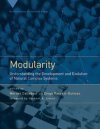About this book
Modularity – the attempt to understand systems as integrations of partially independent and interacting units – is today a dominant theme in the life sciences, cognitive science, and computer science. The concept goes back at least implicitly to the Scientific (or Copernican) Revolution, and can be found behind later theories of phrenology, physiology, and genetics; moreover, art, engineering, and mathematics rely on modular design principles. This collection broadens the scientific discussion of modularity by bringing together experts from a variety of disciplines, including artificial life, cognitive science, economics, evolutionary computation, developmental and evolutionary biology, linguistics, mathematics, morphology, paleontology, physics, theoretical chemistry, philosophy, and the arts.
The contributors debate and compare the uses of modularity, discussing the different disciplinary contexts of "modular thinking" in general (including hierarchical organization, near-decomposability, quasi-independence, and recursion) or of more specialized concepts (including character complex, gene family, encapsulation, and mosaic evolution); what modules are, why and how they develop and evolve, and the implication for the research agenda in the disciplines involved; and how to bring about useful cross-disciplinary knowledge transfer on the topic. Modularity: Understanding the Development and Evolution of Natural Complex Systems includes a foreword by the late Herbert A. Simon addressing the role of near-decomposability in understanding complex systems.
Contents
Series Foreword#vii
Foreword by Herbert A. Simon
Preface
I#INTRODUCTION#1
1#The Ubiquity of Modularity
II#EVO-DEVO: THE MAKING OF A MODULAR WORLD#29
2#Natural Selection and the Origin of Modules
3#Evolutionary Modules: Conceptual Analyses and Empirical Hypotheses
4#Evolutionary Developmental Biology Meets Levels of Selection: Modular Integration or Competition, or Both?
5#Modularity in Evolution: Some Low-Level Questions
6#Evolutionary Lock-In and the Origin of Modularity in RNA Structure
7#Amphibian Variations: The Role of Modules in Mosaic Evolution
III#EVO-PATTERNS: WORKING TOWARD A GRAMMAR OF FORMS#181
8#The Remodularization of the Organism
9#Modularity: Jumping Forms within Morphospace
10#Morphological Modularity and Macroevolution: Conceptual and Empirical Aspects
11#Hierarchical Integration of Modular Structures in the Evolution of Animal Skeletons
12#Modularity in Art
13#Modularity at the Boundary Between Art and Science
IV#MODULARITY OF MIND AND CULTURE#305
14#Evolutionary Connectionism and Mind/Brain Modularity
15#Modularity and Chunking
16#Modularity of Cognitive Organization: Why It Is so Appealing and Why It Is Wrong
17#Decomposability and Modularity of Economic Interactions
18#The Natural Logic of Communicative Possibilities: Modularity and Presupposition
Contributors#435
Index 437
Customer Reviews
Biography
Werner Callebaut is Scientific Manager of the Konrad Lorenz Institute for Evolution and Cognition Research, Vienna, and Professor of Philosophy at Limburg University, Belgium.
Diego Rasskin-Gutman is Ramón y Cajal Research Associate and Head of the Theoretical Biology Research Group at the Institute Cavanilles for Biodiversity and Evolutionary Biology, University of Valencia, Spain. He is the coeditor (with Werner Callebaut) of Modularity: Understanding the Development and Evolution of Natural Complex Systems (MIT Press, 2009).
Contributors:
- Lee Altenberg
- Lauren W. Ancel-Meyers
- Carl Anderson
- Robert B. Brandon
- Angela D. Buscalioni
- Raffaele Calabretta
- Werner Callebaut
- Anne De Joan
- Rafael Delgado-Buscalioni
- Gunther J. Eble
- Walter Fontana
- Fernand Gobet
- Alicia de la Iglesia
- Slavik V. Jablan
- Luigi Marengo
- Daniel W. McShea
- Jason Mezey
- D. Kimbrough Oller
- Domenico Parisi
- Corrado Pasquali
- Diego Rasskin-Gutman
- Gerhard Schlosser
- Herbert A. Simon
- Roger D. K. Thomas
- Marco Valente
- Boris M. Velichkovsky
- Günter P. Wagner
- Rasmus G. Winter
















































